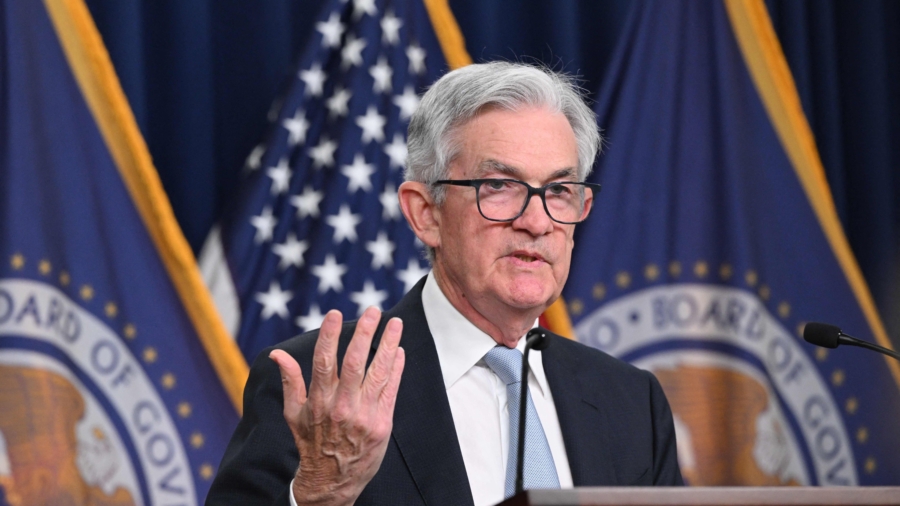Federal Reserve Chair Jerome Powell dashed investors’ hopes for a quick pivot away from restrictive monetary policy, saying during a press conference on Nov. 2 that it’s “very premature” for market participants to be thinking about the central bank hitting pause on rate hikes amid the risk that expectations of higher inflation become entrenched.
In his remarks, Powell left open the prospect for a policy shift “at some point,” telling reporters that the Fed would closely monitor its impact on the broader economy. At the same time, he cautioned that rates would go higher than anticipated.
“We still have some ways to go” in terms of hiking rates to bring inflation back down to the Fed’s 2 percent target, he said, adding that “incoming data since our last meeting suggest that the ultimate level of interest rates will be higher than previously expected.”
Market expectations for the Fed’s terminal interest rate currently sit at 4.92 percent, according to the Federal Reserve Bank of Atlanta’s market probability tracker. Some analysts and Wall Street leaders have said they believe stubbornly high inflation will force the Fed to push them even higher.
Analysts at BNP Paribas, who expect that the U.S. economy will go into a recession in the second quarter of 2023, think the Fed will push interest rates beyond market expectations, to a peak of 5.25 percent.
“We expect a more aggressive Fed response to stickier, more pervasive inflation to push the economy into recession,” BNP said.
Goldman Sachs CEO David Solomon said recently he thinks the Fed will hike rates above market expectations if the central bank doesn’t see any “real changes in behavior” on the part of consumers.
Risk of Entrenched Inflation
In his remarks, Powell said one datapoint that he described as “very concerning” was an uptick in shorter-term inflation expectations, saying they “may be important in the wage-setting process,” suggesting fears of a possible wage-price spiral.
Powell added that the Fed doesn’t have a “clearly identified, scientific way of understanding at what point inflation becomes entrenched,” and so to minimize risk, it’s committed to using its monetary tools “forcefully but thoughtfully” to bring down inflation.
“That’s what we really need to do and what we’re strongly committed to doing,” Powell said.
Before Powell spoke to reporters on Wednesday, U.S. stocks were approaching their highest levels in weeks. But his remarks appeared to dash investor hopes for a faster pause in rate hikes, sending equities tumbling.
The benchmark S&P 500 Index fell 2.5 percent on Wednesday, the Dow Jones Industrial Average dropped 1.55 percent, and the tech-heavy Nasdaq tumbled 3.39 percent.
‘Sustained Period of Below-Trend Growth’
Powell said that he sees no evidence that the Fed has moved too fast on rate hikes or that the central bank has overtightened.
“I think it’s very difficult to make a case that our current level is too tight, given that inflation still runs well above the federal-funds rate,” he said.
Prior to his press conference, Fed policymakers decided to raise rates by 75 basis points, putting the federal funds rate within a range of 3.75–4.00 percent, its highest level in 15 years.
Inflation, as measured by the Consumer Price Index (CPI), came in at an annualized 8.2 percent in September, down from a recent June peak of 9.1 percent.
The Fed chief said the fight to cool inflation would likely require a “sustained period of below-trend growth” as well as “some softening of labor-market conditions.”
The number of job openings, a key measure of labor market strength, rose from 10.1 million in August to 10.7 million in September, according to the Department of Labor. With around 5.75 million unemployed persons, there are around 1.9 jobs available for every jobless individual in the United States.
Powell said that despite the likelihood that the Fed’s monetary tightening will slow the economy, the risk of inaction is greater than that of a downturn.
“The historical record cautions strongly against prematurely loosening policy. We will stay the course until the job is done,” he said.
Greg McBride, chief financial analyst at Bankrate, told The Epoch Times in an emailed statement that he thinks that stubbornly high inflation will force the Fed to keep hiking and lead to a slowdown.
“Unfortunately, we’re likely to feel the pain of a slower economy before we see the gain of lower inflation.”
Analysts at ING said in a note that they expect the Fed to deliver two more 50 basis-point hikes at each of its two upcoming meetings before a recession forces a pause.
“By the time of the March FOMC [Federal Open market Committee] meeting, we are predicting the U.S. to have entered a recession with slowing rents, falling used car prices, and rapidly receding corporate pricing power contributing to far more convincing signs that inflation is moderating,” they wrote.
From The Epoch Times


